
Best electric cars in 2024
Last updated December 28, 2022
UK motorists are under pressure to ditch their petrol and diesel engines and make the switch to pure-electric cars (BEVs). But which are the best electric cars available to buy?
Whilst the number of electric car sales in the UK remains relatively small compared to the combustion alternatives, things are changing. There’s a wide selection of electric cars emerging on the market, and as more manufacturers get on board with electric technology these numbers will only grow further. This will result in models with longer ranges, faster charging times and most importantly, lower prices.
At the same time, EV charging infrastructure in the UK is improving too, meaning that owning electric cars will be more viable for more motorists. Fast chargers are more frequently available in homes, workplaces, and public spaces, making it easier than ever to make the swap to a battery powered electric vehicle and enjoy lower running costs.
So, here are some of our favourite electric cars in 2024.
Value your car in under 30 seconds
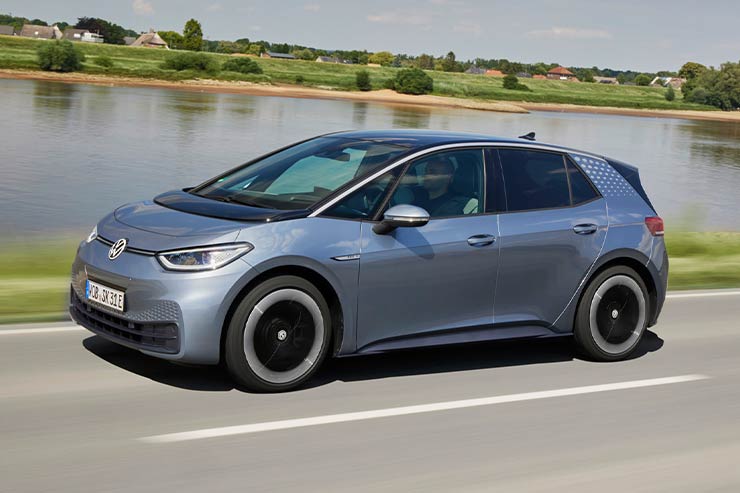
Volkswagen ID.3
The ID.3 was Volkswagen’s first pure-electric car when it opened for orders in October 2020, with the 45kW Pure Performance models added in April 2021. It is a capable, family hatchback that places a focus on being affordable, practical, and aesthetically pleasing. The ID.3 was a first look into Volkswagen’s future, with futuristic looks on the outside and an abundance of technology inside the cabin.
Volkswagen ID.3 battery and range
There are three different batteries on offer with the ID.3.
The entry-level battery is the Pure Performance 45kWh, and it’s claimed to have a range of 217 miles on a single charge. It comes with a 148bhp motor that allows the car to reach 0-62mph in a time of 8.9 seconds.
The 58kWh battery option is available with two power outputs; in the Pro it generates 143bhp, but if you opt for Pro Performance, it has 201bhp, reaching 0-62mph in just 6.6 seconds.
The larger Pro S 77kWh battery powers the same 201bhp motor, although the 0-62mph time is slower at 7.9 seconds due to the heavier battery. However, this is more suited to drivers who regularly travel long distances, with the car able to travel 336 miles on a single charge.
At home, the ID.3 can charge up to 7.4kW and will take around nine hours to fully charge from empty. However, where you can make use of 100kW rapid chargers, you could recharge the battery to 80% in as little as 33 minutes.
Volkswagen ID.3 trims and specs
The ID.3 comes with five different trim options: Life, Family, Style, Max, and Tour.
The entry-level Life starts at £29,365 and comes with a good selection of basic equipment. You’ll find 18” steel wheels, automatic LED lights, automatic wipers, front and rear parking sensors, adaptive cruise control, climate control, a leather-wrapped multifunction steering wheel, ambient LED lighting, a 10” touchscreen infotainment system with sat-nav and smartphone mirroring, heated front seats and a heated steering wheel. It also comes with safety features such as automatic emergency braking and lane-keep assist.
The Family trim starts at £33,655 and introduces kit such as privacy glass, a rear-view camera, improved seats, a ski flap, two-zone climate control and a variable boot floor.
Style introduces 18” alloys, keyless entry, ambient interior lighting and illuminated door handles, for an increased price of £33,735.
Max offers yet more kit, including front seats with adjustable lumbar support and massage functionality, a panoramic sunroof, a head-up display, an uprated sound system, adaptive suspension, and progressive steering – the price for this trim starts at £37,745.
Finally, the Tour has the same equipment as standard, but comes with the largest battery available, bumping up the price to £37,815.
Find out more about the Volkswagen ID.3 here.
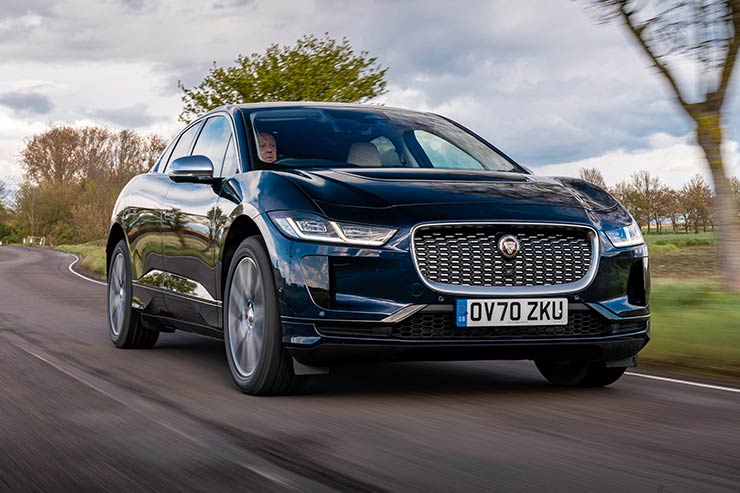
Jaguar I-PACE
The Jaguar I-Pace is the manufacturer’s first all-electric performance SUV, making it an extremely appealing choice in the current market. If you’re in the market for a premium SUV with excellent performance figures, practicality and range then the I-Pace could be the perfect choice.
In 2021, there was a major overhaul to the car’s infotainment system, which brings the system in-line with their German competitors. The update means that the system is essentially always on and can accept updates without requiring a trip to the dealership. Jaguar’s basic package remains the same – it’s a comfortable car with space for four, and a decent boot of 577L with the seats up.
Jaguar I-PACE battery and range
The only battery option available with the I-Pace produces 90kWh and has an official range of up to 290 miles on a single charge. Every Jaguar I-PACE has four-wheel drive courtesy of two electric motors, one at the front and another at the rear. Together they produce an impressive 395bhp, which allows the car to reach 0-60mph in 4.5 seconds.
The best thing about the I-PACE is the way it drives, with exceptional performance and handling – in effect, it is everything that an electric Jaguar should be. With an approved Jaguar wall box installed, a full charge can be achieved in approximately 13 hours at home.
Jaguar I-PACE trims and specs
There are five different trim options: S, SE, Black, HSE and HSE Black.
It’s important to bear in mind that with premium vehicles come premium prices, and even the entry-level S starts at £65,245. However, it does include many luxury features as standard including keyless entry, dual-zone climate control and ambient interior lighting. Standard safety kit includes lane-keep assist, low-speed automatic emergency braking and a traffic sign recognition system.
The SE jumps the starting price up to £65.689 and will get you larger alloy wheels, electric front seats with memory function, and a secondary touchscreen. The list of safety equipment grows to include a blind spot warning system and high-speed automatic emergency braking.
Upgrade to Black trim and you’ll find keyless entry and start, windscreen heating, voice-controlled navigation, and electric heated/power fold memory door mirrors, with approach lights and auto dimming driver side – all for the price of £72,445.
Finally, the HSE Black brings a panoramic glass roof, exterior temperature display, windscreen heating, an online pack with a data plan, a third-party sound system and optional alloys for no extra cost, although you will have to pay the starting price of £76,695.
Find out more about the Jaguar I-PACE here.
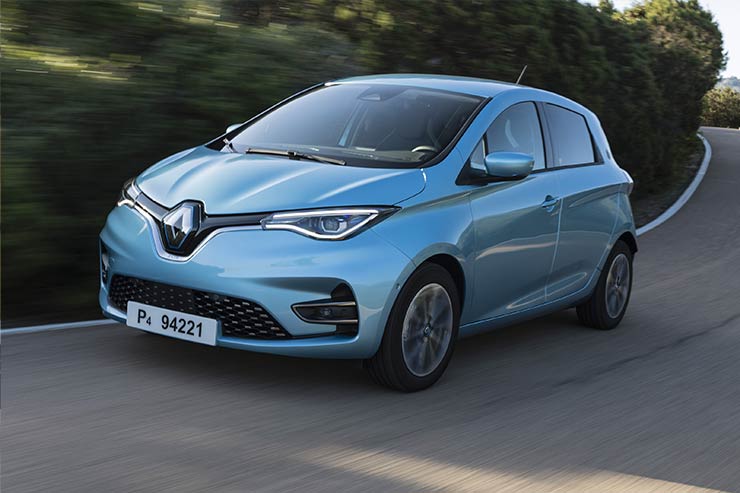
Renault ZOE
This is one of the smaller and more affordable cars on our list. Constant updates mean the Zoe has benefitted from Renault’s latest electric developments and makes it an electric city car that is well worth considering. Equipment levels are good, and the line-up is broad for an electric model, with three trim levels for buyers to choose from.
Renault ZOE battery and range
It’s available with either a 107bhp motor called the R110, or a 134bhp motor known as the R135.
You might not notice a massive acceleration difference at city-speed, but the R135 can get you up to motorway speeds much more swiftly – 0-62mph can take as little as 9.5 seconds, compared to 11.4 in the R110.
Providing you have an outlet, you can charge the Zoe from home overnight to a range of up to 245 miles – or you can upgrade to the high-tech 50kW DC rapid charger, which can recover up to 90 miles of driving range in as little as 30 minutes.
Renault ZOE trims and specs
The Zoe is available in three trim levels: Play, Iconic, and GT Line.
The entry-level Play trim is only available with the R110 motor and is thus the cheapest route into Zoe ownership with a starting price of £26,788. It comes with the 7” infotainment system with smartphone mirroring as standard, plus a DAB radio and two USB sockets. Driving tech includes cruise control, although you have to do without some important safety kit like automatic braking. This is also the only trim that can’t benefit from the optional fast 50kW DC charging.
Starting at £27,891, the Iconic is available with either the R110 or R135 motor. As well as adding a built-in sat nav, the Iconic trim also brings wireless smartphone charging, climate control and rear parking sensors. You also get 100% recycled seat upholstery and fabric inserts on the dashboard. Safety systems include lane keeping assistance and traffic sign recognition, although automatic emergency braking is an optional add-on, and well worth the addition.
Finally, the top-spec GT-Line starts at £29,087 and is only available with the R135 motor. It brings along with it a larger 9.3” infotainment touchscreen with sat nav, synthetic leather and recycled cloth upholstery, a reversing camera and blind spot monitoring, with automatic emergency braking as standard.
Additionally, the Zoe comes with an eight year/100,000-mile warranty on all trims. Find out more about the Renault Zoe here.

Tesla Model 3
The Model 3 is a compact executive saloon, rivalling the likes of the Mercedes C-Class and BMW 3 Series in an extremely competitive market. The Model 3 is also Tesla’s smallest and cheapest model to date.
Tesla combines a minimalist style, space-age technology, impressive range figures, grin-inducing performance, and cutting-edge charging tech supported by the expansive and dedicated Tesla supercharger network.
Tesla Model 3 battery and range
The entry level Standard Range Plus model claims it can achieve up to 267 miles on a single charge, but performance is not sacrificed to achieve this. The electric motor drives the rear wheels and powers the car from 0-60mph in 5.3 seconds with a top speed of 140mph.
The four-wheel drive Long Range trim has two electric motors and a larger battery for a range of 360 miles, with a 0-60mph figure of 4.2 seconds.
The Model 3 Performance can scorch from 0-60mph in 3.1 seconds and is still capable of driving up to 352 miles on a full charge.
Tesla Model 3 trims and specs
There are three choices when it comes to the Tesla Model 3 as outlined above.
Even the entry-level Model 3 comes with plenty of luxuries including climate control, adaptive cruise control, faux leather seats (heated in the front), an electric tailgate and keyless entry via a smartphone app. The interior is minimalist and very different from what you would expect to find in a BMW, Mercedes, or Audi. Prices start at £40,990 and jump to £48,490 for the Long Range.
In addition to an extended range, the Long Range comes well-equipped with LED headlights, power-folding mirrors, electrically operated front seats and steering column, heated front and rear seats, a 15” infotainment screen with Google Maps, Netflix and web browsing, a premium audio system, wireless smartphone charging, a rear-view camera and all-round parking sensors.
Finally, the Performance starts at £59,990 and adds jaw-dropping performance, as well as 20” alloys and sports suspension to all of the above.
Find out more about the Tesla Model 3 here.
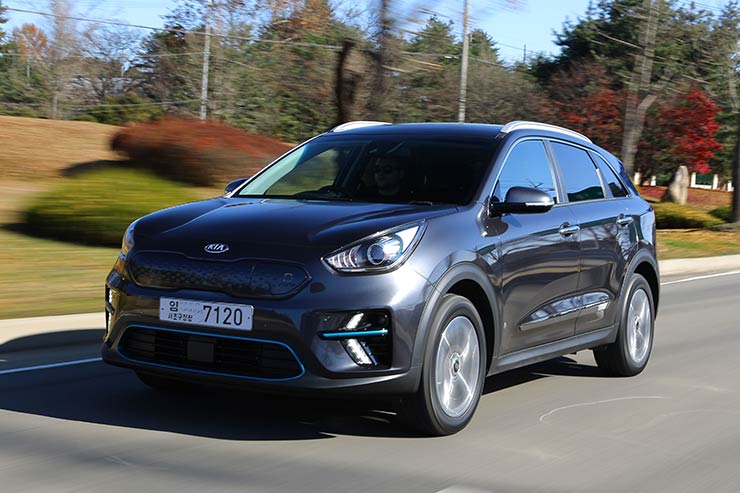
Kia e-Niro
As an electric SUV that offers enough space for everyday family use, and long range in the top-spec models, it was increasingly difficult to get hold of an e-Niro in early 2020 due to overwhelming popularity, but they’ve now managed to judge the demand and improve their manufacturing capacity.
The styling is a little conservative, with a functional but uninspiring cabin; but, if utilitarianism is for you, then this may be the perfect EV.
Kia’s battery is among the best in the business, to the point where you can’t fail to be impressed as it nudges down the range in individual miles, instead of being overly optimistic or pessimistic about its reserves.
Kia e-Niro battery and range
There are two batteries available on the e-Niro, with the entry level 39kWh battery getting a 134bhp electric motor. This is the same motor and battery combo that’s used in the entry-level Hyundai Ioniq Electric and delivers respectable performance. It can achieve 0-60mph in 8.2 seconds and can officially manage 180 miles.
The other battery option is 64kWh, which has a 201bhp electric motor that can get from 0-60mph in 6.5 seconds. The 64kWh has an impressive official range of 282 miles, bettering many of its rivals. Using a 7.4kW dedicated home wall box, the e-Niro will take 10 hours and 30 minutes to charge from empty to full.
Kia e-Niro trims and specs
There are three trim options available: 2, 3, and 4+.
Even the entry-level 2 is well equipped, with dual-zone climate control, 17” alloys, automatic lights and wipers, power-folding door mirrors, driver’s adjustable lumbar support, keyless entry and start, a 7” driver’s display, an auto-dimming rear-view mirror, adaptive cruise control, a six-speaker stereo, rear parking sensors, a rear-view camera, automatic emergency braking and lane assist. Prices start at £32,895 and jump up if you want the Long-Range edition.
The 3 model starts at £37,400 and adds full leather upholstery, a heated steering wheel, 8-way electrically adjustable (including lumbar adjustment) heated front seats, wireless phone charging, front parking sensors, and a larger 10.25” infotainment screen with built-in sat nav and online features. It also brings the larger 64kWh battery.
Finally, to upgrade to the 4+ you will pay a minimum of £39,695 but will gain a tilt and slide sunroof, LED headlights, a memory function for the driver’s seat and door mirrors, ventilated front seats, heated outer rear seats, ambient lighting, a JBL stereo and extra safety kit including blind spot monitoring.
Find out more about the Kia e-Niro here.
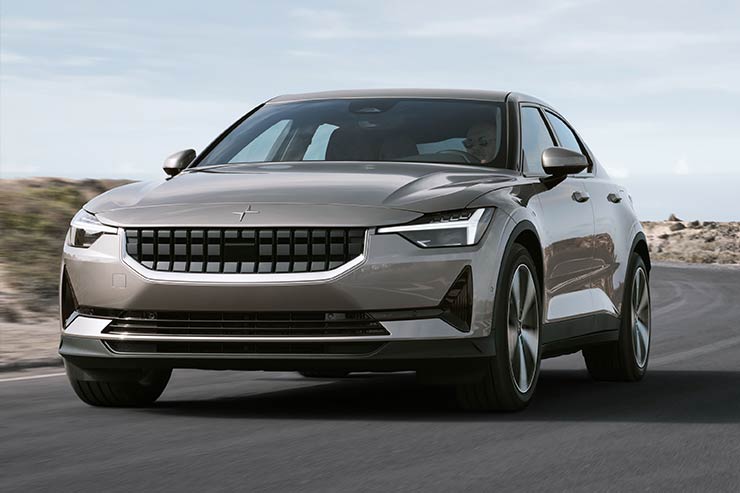
Polestar 2
With the Tesla Model 3 proving a firm favourite with electric saloon buyers, Volvo-offshoot Polestar is hoping to offer perhaps the most convincing alternative.
This is a stylish, competitively priced Scandinavian saloon car with an upmarket interior and a performance to rival most sports cars. You aren’t spoiled for choice with trims, but the Polestar 2 does come with a long list of personalisation options.
Polestar 2 battery and range
This performance saloon features a choice of three batteries.
At launch, it was available only in four-wheel drive, dual motor form, but now it can be bought with a single motor on the front axle, providing either 221bhp or 227bhp. Despite the slight difference in power, both options get from 0-60mph in 7.4 seconds.
The larger 78kWh battery and dual electric motors offer a combined 402bhp. 0-62mph takes just 4.7 seconds, and it can reach a top speed of 127mph. Vitally, a maximum range of 292 miles means Polestar is the first electric saloon to stand out as a credible alternative to its Tesla counterpart.
The Polestar 2 is capable of recharging at up to 150kWh too, so speedy top-ups are on the cards if you can find a rapid or ultra-rapid charger.
Polestar 2 trims and specs
As we’ve already mentioned, there is only one version of the Polestar 2 on the market, with a variation of three batteries.
However, you’ll get front and rear power windows, automatic windscreen wipers and LED headlights, rear park assist, keyless start, digital instrument cluster and a long list of options to personalise the car. The standard range single motor starts at £39,845, with the long-range sitting at £52,845.
Find out more about the Polestar 2 here.
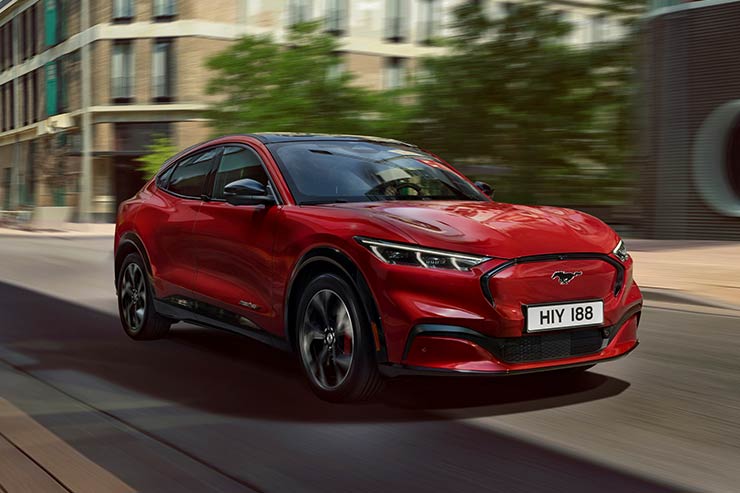
Ford Mustang Mach-E
This is Ford’s first all-electric SUV and a definitive electric vehicle. Whilst the Mustang Mach-E is nothing like its iconic sports car namesake, it is a well-crafted electric SUV that still offers a breadth of skills.
Ford Mustang Mach-E battery and range
There are four different battery options, beginning with the entry-level Standard Range RWD.
RWD stands for ‘rear wheel drive’ and these wheels are powered by an 86kWh battery and 265bhp motor delivering 0-62mph in 6.9 seconds - quick by most standards and it zips you along nicely in any real-world scenario.
You’ll find the same battery capacity and power from the Standard Range AWD (all-wheel drive, with one motor driving the front wheels and another for the rear). It’s a bit quicker, with 0-62mph taking 6.3 seconds, and it has an official range of 248 miles.
The Extended Range RWD model ups the power to 290bhp but with a bigger battery to haul around it isn’t as quick as the Standard Range model. However, it has a massive official range of 379 miles, one of the best of any electric car and even tops the Tesla Model 3.
Finally, there’s the top-spec Extended Range AWD, which packs 346bhp from its dual electric motors and hits 0-62mph in a brisk 5.8 seconds. This has an official range of 335 miles.
To fully charge the Mustang Mach-E from empty to full with the 240V Ford Mobile Charger, it would take approximately 15 hours. With a faster charger able to deliver 10.5kW, the charge time drops to around 10 hours.
Ford Mustang Mach-E trims and specs
There are three different trim options: Standard Range, Extended Range, and First Edition.
Starting at £41,330, the entry-level Standard Range comes with LED headlights, privacy glass, blind spot warning, traffic sign recognition, two-zone climate control, heated front seats, a heated windscreen, heated steering wheel, a 15.5” infotainment system including sat nav and smartphone mirroring, wireless phone charging, adaptive cruise control, front and rear parking sensors, a rear-view camera and keyless entry as standard.
The Extended Range jumps in price to £49,980 and adds a 360º parking camera, hands-free tailgate, a 10-speaker B&O Premium Sound system including a dashboard soundbar, advanced active park assist and a full panorama roof.
Top of the range First Edition costs £58,080, and adds 19” black machined alloys, and is available in an exclusive colour as well as containing a larger 88kWh battery.
Find out more about the Ford Mustang Mach-E here.

Tesla Model S
The Model S was arguably the first all-electric car that you could easily use in place of a combustion-engine equivalent when it first launched eight years ago.
The most recent line-up comprises two high-end models, the Performance and Long Range Plus, both offering long range and practicality to compliment the typically excellent levels of battery powered performance.
If you’re a potential Mercedes S Class or Porsche Panamera buyer, then the Model S should stand out as the electric alternative. It’s a lot bigger than the Model 3 and hugely practical, with up to 804 litres of boot space and optional rear-facing child seats, turning it into a 7-seater.
Tesla Model S battery and range
The battery and motor technology are what make the Model S stand out.
The entry-level Long Range model officially blasts from 0-60mph in just 3.7 seconds. With an enormous 100kWh cell the Long Range is capable of 405 miles on a single charge, backed up by Tesla’s 150kWh supercharger network. The Plaid model can cover 367 miles in real-world range, with a 100kWh battery.
Tesla Model S trims and specs
Like the Model 3, this comes at a price: the Long Range entry-level starts at £91,980, with the highest spec Plaid costing £138,990.
The Long Range sees an extensive equipment list, with keyless entry and go, cruise control, adaptive steering, electric boot/tailgate, automated high-beam assist, fixed panoramic glass roof, ambient lighting and more.
The Plaid trim sees a trip computer, Bluetooth hands-free phone with voice control, smart air suspension, electric/heated/folding door mirrors with memory and more.
Find out more about the Tesla Model S here.
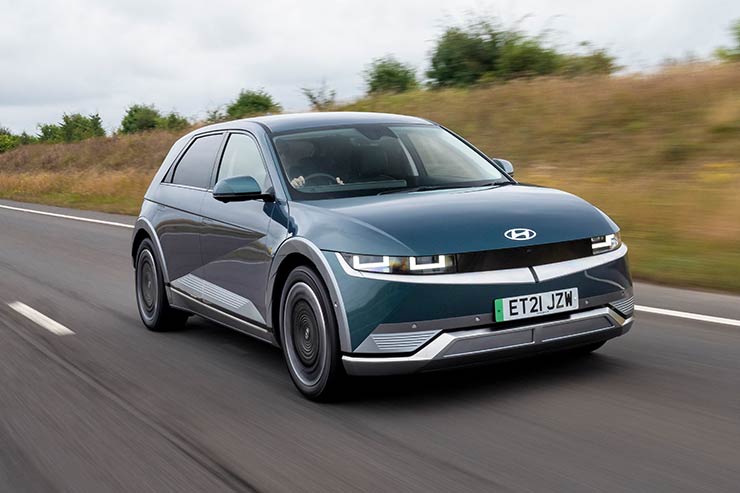
Hyundai Ioniq 5
This is a truly impressive EV, showcasing next-generation electric car tech alongside capable performance and charging ability normally reserved for high-end models like the Porsche Taycan (which we’ll discuss momentarily).
It’s a large electric car styled to look like a hatchback rather than an SUV or saloon but is very similar in size to cars in the latter categories.
Hyundai Ioniq 5 battery and range
Two battery options are available with three power outputs: the entry 58kWh battery is paired with a single 168bhp motor powering the rear wheels, which delivers a 0-62mph time of 8.5 seconds and a range of 238 miles.
The 214bhp mid-spec version offers the best range with a 73kWh battery, increasing the total distance able to be covered on a single charge to 280 miles.
The top-spec variant uses the same 73kWh battery but adds a second motor at the front giving a combined total of 301bhp and 605NM of torque. The range falls slightly to 267 miles, but performance is much improved with 0-62mph taking 5.2 seconds.
Hyundai Ioniq 5 trims and specs
There are three different trims available: SE Connect, Premium, and Ultimate.
Even the basic trim is well equipped, featuring 19” alloys, lane-keep assistance, rear-view camera, interior mood lighting, wireless phone charging and a 12.3” infotainment screen with smartphone mirroring and a DAB radio. It starts at £36,695, whilst upgrading to Premium increases this to £39,295.
You’ll find all the kit found in the SE car, plus dual LED projector headlamps, chrome side mouldings, a powered tailgate, four-way electric driver’s seat adjustment, and heating for both the steering wheel and both front seats. Extra safety kit including blind spot monitoring also come as standard.
The Ultimate trim starts at £42,295 and brings leather upholstery, privacy glass, chrome door garnish, fully electrically adjustable and ventilated front seats, heated rear seats, a Bose premium sound system and a head-up display. It also adds 20” alloys to the 73kWh battery models.
Find out more about the Hyundai Ioniq 5 here.
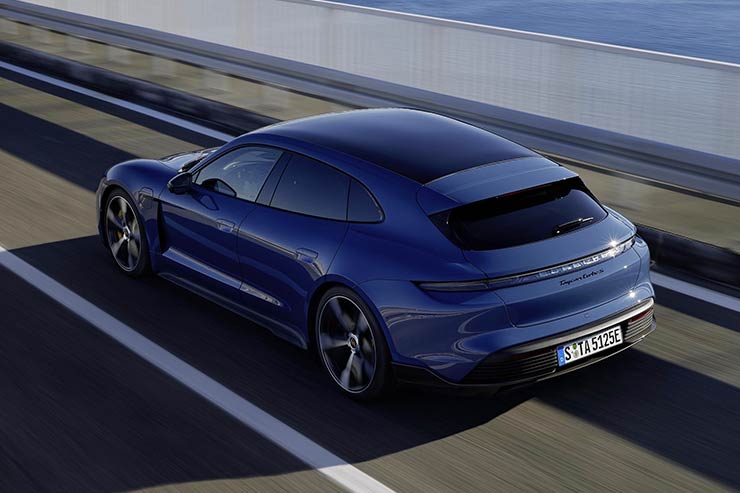
Porsche Taycan
The Porsche Taycan is a truly brilliant car to drive, remaining true to its maker’s heritage and leaving you with no doubt that this is a proper Porsche sports saloon.
The Taycan delivers sports car-like handling with ferocious acceleration and great agility – yet still offers four seats and a usable range. It isn’t often that a car comes along that feels revolutionary, but the Taycan shows how much fun a plug-in future can be by retaining all its manufacturer’s sports car characteristics.
Despite being a hefty 2.2 tonnes in weight, it hides its bulk well and can weave neatly through tight corners and bends. The Taycan clearly defines how Porsche sees its future in the changeover from combustion engines to electric power.
Porsche Taycan battery and range
The Taycan’s raw pace is outstanding; in standard 523bhp 4S guise it manages 0-62mph in 4.0 seconds, although if you upgrade to the 750bhp Turbo S version this is an eye-watering 2.8 seconds. It should also be easy to live with as a daily driver – refinement is great and while comfort is firm, the air suspension will do its job of dealing with the broken, uneven tarmac common on UK roads.
The Performance Battery Plus sits at 93kWh and gives a consistent 469bhp or 523bhp output for a quick burst that got it from 0-60mph in 3.6 seconds. The entry level can do the most miles on a charge (301), and the Performance Battery Plus can achieve 288 miles. The Turbo sits at 281 miles, and the Turbo S 259 miles.
Porsche Taycan trims and specs
Unsurprisingly, none of this comes cheap; the entry level model starts at £72,850, and the top spec Turbo S begins at a whopping £140,696.
There are four trims overall: the Taycan, 4S, Turbo and Turbo S.
The entry-level comes with 19” wheels, two-zone climate seats, a partial-leather interior, keyless start, front and rear parking sensors, three touchscreens, smartphone connectivity capabilities, sat nav, cruise control, eight-way electric front seats, wireless phone charging, four USB-C ports, a 10-speaker stereo and LED headlights.
The 4S comes with all the above, as well as a heat pump to condition the battery for maximum range and sits at £84,085.
The Turbo starts at £116,925 and brings metallic paint, heated front and rear seats, extended leather trim, adaptive Matrix LED headlights, 14-way powered front seats, and a 14 speaker Bose stereo.
Finally, the range-topping Turbo S adds 21” alloys, an ‘engine’ sound generator, Sports Chrono package, four-wheel drive, ceramic brakes and a leather-free interior.
Find out more about the Porsche Taycan here.

